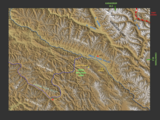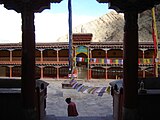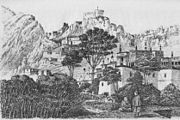Hemis National Park
Hemis National Park
Hemis NP | ||
|---|---|---|
National Park | ||
Precipitation | 160.5 millimetres (6.32 in) | |
| Avg. summer temperature | 15 °C (59 °F) | |
| Avg. winter temperature | −30 °C (−22 °F) | |
Hemis National Park is a high-elevation
The park is bounded on the north by the banks of the
History
The park was founded in 1981 by protecting the Rumbak and Markha catchments, an area of about 600 km2 (230 sq mi). It grew in 1988 to around 3,350 km2 (1,290 sq mi), by incorporating neighbouring lands,[2] before increasing in 1990 to 4,400 km2 (1,700 sq mi),[3] and is the largest national park in South Asia.
Geography and ecological significance
The park lies within the
Fauna
The park is home to a viable breeding
The
Among
16 mammal species and 73 bird species have been recorded in the park so far.[6]
-
Mountain weasel (Mustela altaica)
Flora
This region is in the
Environmental issues
Over 1,600 people live inside the park boundaries, mostly pastoralists raising poultry, goats, and sheep. This results in considerable animal-human conflict within the region. Snow leopards prey on livestock, sometimes killing several animals from a single flock in one hunt. This has been attributed to the overgrazing of livestock. Crop damage caused by bharal has also been seen.
The Department of Wildlife Protection, Government of Jammu and Kashmir is the custodian of the park. Any activity in the park is prohibited unless special permission is obtained from the Chief Wildlife Warden J&K. The department has initiated many projects for biodiversity conservation and rural livelihood improvement in Ladakh, including the Hemis National Park, such as:
- Project Snow Leopard for Conserving the entire Himalayan biosphere. The project was initiated by the department in 2004 and was formally launched on 20 February 2009.
- Ladakh Eco tourism Project
- Ladakh Home stays: A program for providing tourists with access to home stays in local villagers' residences (source of additional income).
- Nature Guide Training for the educated unemployed youth.
- Eco Cafe for the women Help Group to run the cafe and sell the local handicraft products to the tourist.
- Creation of a no-grazing zone for domestic livestock
- Predator-proofing livestock pens in the area[3][5]
Tourism
The park offers a number of routes for trekking from mid-June to mid-October; some of these trekking routes are among the most popular in Ladakh. This includes the Markha valley trek and the trek from Spituk to Stok over the Ganda La pass.
- Nearest airport: Leh Kushok Bakula Rimpochee Airport, Leh district about 5 km (3.1 mi) away
- Nearest highway: Kargil- Leh), both near the northern borders of the park
- Nearest town: There are quite a few villages, and gompas (monasteries) inside the national park
- Nearest city: The city of Leh is 10 km (6.2 mi) to the north of the park.
Check posts at the park boundaries
There is no metalled road in Hemis National Park. However, a few rough roads enable local people to reach their villages. There is a rough road connecting Chilling bridge to Skiu village in the Markha valley and another one connecting Spituk to Zingchen and Rumbak village. On Hemis side, there is a road connecting Martselang to Shang Sumdo.
In order to protect the national park and its tourism-related activities (trekking, homestays, wildlife spotting), the in inhabitants of the region demanded in 2018 a regulation of vehicle access to the park. Since 2019, ALTOA (All Ladakh Tour Operator Association) and the Department of Wildlife Protection have set up check posts at each entrance of the Hemis National Park. These check posts are located at Skiu village, at Zingchen, and at Shang Sumdo. Beyond these check posts, only motorized vehicles used by villagers who live inside the park are allowed. Tourists are not allowed to use motorized vehicles inside the park, they shall walk. Tourists also need to pay a fee (called “wildlife fee”) when entering the park.
Ganda La
| Ganda La | |
|---|---|
Himalaya |
Ganda La (also called the Kanda La,
The Markha Valley trek crosses the pass on the section between
Gallery
- Hemis NP
-
The top of Ganda La Winter Pass on the way toSkiu
-
Mountain Range in the eastern part of the park
-
A terrain map of Hemis National Park and the surrounding trans-Himalayan Ranges
-
Courtyard of the historic Hemis Monastery inside the NP
-
Hemis monastery in the 1870s
-
Stok Kangri, the highest peak inside the park boundaries
In culture
The park houses numerous Tibetan
The 400-year-old
The national park, monastery and the Changthang Wildlife Sanctuary were prominently featured in the award-winning documentary Riding Solo to the Top of the World.
See also
- Karakorum Wildlife Sanctuary
- Changthang Cold Desert Wildlife Sanctuary
- Tourism in Ladakh
References
- ^ http://www.cloudbirders.com/tripreport/repository/BARUAH_India_03_2014.pdf [bare URL PDF]
- ISBN 9788170411000)
- ^ a b http://www.snowleopardnetwork.org/bibliography/anlp99.htm[permanent dead link]
- ^ Wild Sheep and Goats and Their Relatives: Status Survey and Conservation Action Plan for Caprinae
By David M. Shackleton, International Union for Conservation of Nature and Natural Resources Species Survival Commission. Caprinae Specialist Group
Contributor David M. Shackleton, Published by IUCN, 1997 (ISBN 9782831703534)
- ^ National Geographic Magazine, June 2008
- ^ a b c d e Khan, Asif (2016). "Ladakh: The Land Beyond". Buceros. 21 (3): 6–15.
- ^ Kala, CP 2005. Indigenous Uses, Population Density, and Conservation of Threatened Medicinal Plants in Protected Areas of the Indian Himalayas. Conservation Biology, 19 (2): 368-378 http://onlinelibrary.wiley.com/doi/10.1111/j.1523-1739.2005.00602.x/abstract
- ISBN 9788173871283)
- ^ "Markha valley trek, Ladakh".
- ^ Majumdar, Swapna (9 December 2017). "Himalayan Homestays". The Hindu.
- ^ ISBN 978-1-85284-675-6.
- ^ "Hemis National Park on Google Maps". Retrieved 28 October 2016.
Bibliography
- Management Plan Hemis High Altitude National Park, Jigmet Takpa IFS and Saleem Ul Haq.
- Hemis High Altitude National Park-Government of Jammu and Kashmir, Department of Wildlife Protection, Wildlife Division(LAHDC) Leh-Ladakh
- Chettri, Nakul. 2003.
- Namgail, T., Fox, J.L. & Bhatnagar, Y.V. (2004). Habitat segregation between sympatric Tibetan argali Ovis ammon hodgsoni and blue sheep Pseudois nayaur in the Indian Trans-Himalaya. Journal of Zoology (London), 262: 57-63.
- Ladakh: The Land and the People, By Prem Singh Jina. Published by Indus Publishing, 1996 (ISBN 9788173870576)







